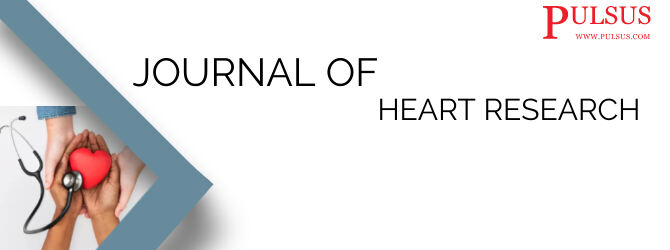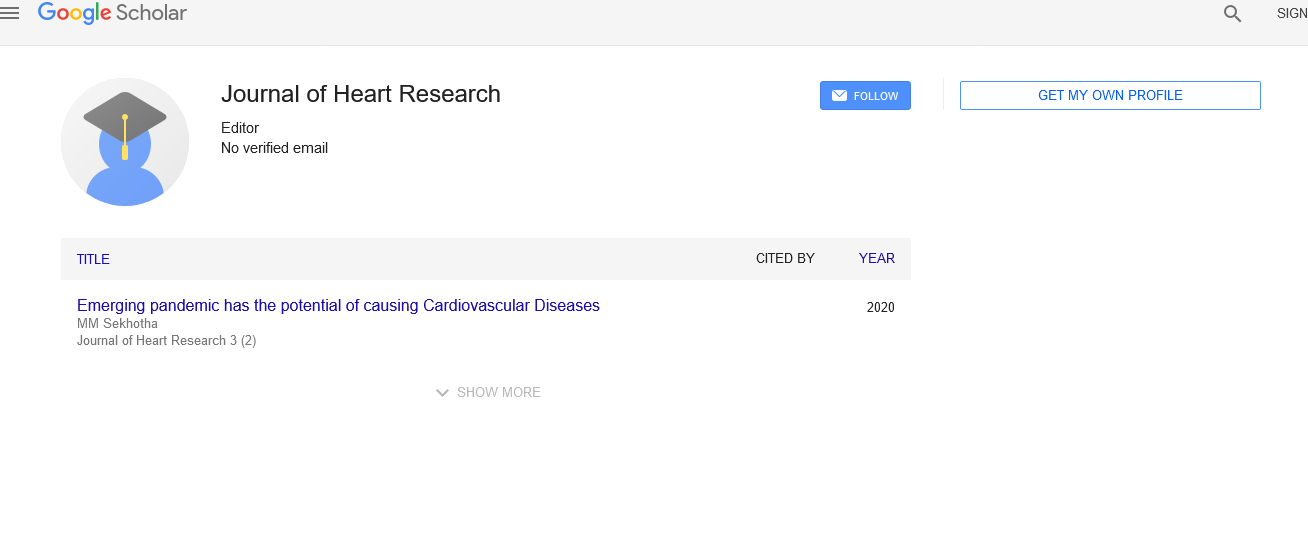Role of serotonin in heart valve disease progression
Received: 02-Jun-2022, Manuscript No. puljhr-22-5035; Editor assigned: 05-Jun-2022, Pre QC No. puljhr-22-5035 (PQ); Accepted Date: Jun 22, 2022; Reviewed: 15-Jun-2022 QC No. puljhr-22-5035 (Q); Revised: 18-Jun-2022, Manuscript No. puljhr-22-5035 (R); Published: 25-Jun-2022, DOI: 10.37532/puljhr.22.5 (3).21-22
Citation: Miller S. Role of serotonin in heart valve disease progression. J Heart Res. 2022; 5(3):21-22.
This open-access article is distributed under the terms of the Creative Commons Attribution Non-Commercial License (CC BY-NC) (http://creativecommons.org/licenses/by-nc/4.0/), which permits reuse, distribution and reproduction of the article, provided that the original work is properly cited and the reuse is restricted to noncommercial purposes. For commercial reuse, contact reprints@pulsus.com
Abstract
Some serotoninergic medications and neuroendocrine tumors that produce serotonin (5-HT) have been shown to cause valvular heart disease by stimulating valve cell proliferation via contact with a 5-HT receptor type 2B. Serotonin may play a role in the pathophysiology of progressive valvular disease, such as rheumatic fever complications, people with congenital bicuspid aortic valves, or patients with degenerative aortic valve stenosis. Both the right and left-side cardiac valves appear to be affected by the first inflammation in acute rheumatic fever. Chronic right-sided valve illness occurs in some patients, particularly in those with septum anomalies, whereas left-sided valves are generally afflicted, implying that high flow velocity and systemic pressure adjacent to the valves may play a role in the etiology. Serotonin is carried in granules in blood platelets.
Keywords
serotonin; heart valve disease; tumor; inflammation; valvular illness
Introduction
Serotonin is released locally by shear stress while passing through a defective valve, according to changes in platelet num- -ber and concentrations of chemicals released by platelets in individuals with valvular illness. As a result, any functional alterations in the valves (such as bicuspid aortic valves and changes caused by degeneration) may proceed as a result of locally produced serotonin. Local serotonin measurement is not achievable due to serotonin release during plasma sampling and preparation. However, we believe that serotonin may have a role in valvular illness in general, and that patients may benefit from treatments that reduce serotonin's effect on the heart. Heart valve dysfunctions such as stenosis or insufficiency are significant disorders that, if left untreated, can lead to heart failure. The possible therapeutic alternatives include valve replacement by open cardiac surgery or percutaneous catheter method. To yet, no pharmaceutical treatments have been found to be effective. A century ago, acute rheumatic fever was the leading cause of valvular heart disease, but it has all but vanished from the Western world in recent decades [1]. Aortic valve stenosis can be caused by a variety of factors, including congenital bicuspid aortic valves. Furthermore, small intestinal Neuro-Endocrine Tumor (NET) induced valve damage on the right side of the heart is well-known.
Rheumatic Heart Disease Following Acute Rheumatic Fever (ARF)
Streptococcal infection, which commonly begins in the throat, causes ARF [2]. The method by which streptococcal infection causes heart and brain affection, resulting in chorea, is unknown, however, similarities between antigens at affected structures and specific streptococcal strains have been widely accepted [3]. Nonetheless, no evidence of a direct bacterial infection of the heart or brain has been found. By establishing immunity or taking antibiotics, the patient may be able to overcome the causative streptococcus Inflammation of the affected organs, such as the heart and brain, occurs during the acute phase of the infection or with subsequent reinfections.
Echocardiography can detect subclinical valve inflammation during the acute phase and can also be used to diagnose heart failure. When the streptococcus is destroyed, the inflammation subsides, and the patient becomes asymptomatic. Due to the progressive degradation of cardiac valves, most commonly on the left side of the heart that is exposed to systemic pressure; cardiac symptoms may resurface after decades. Surprisingly, right-sided valves that are subjected to lesser pressure rarely acquire chronic alterations. Septal deficiencies, which cause greater pressure in the heart's right chambers, are more prone to valvular alterations [4]. This shows that the initial rheumatic inflammation affects all of the heart's valves. Flow variations with shear stress may thus play a significant influence in the evolution of valvular abnormalities.
Aortic Stenosis in Congenital Bicuspid Aortic Valve
Bicuspid aortic valve affects up to 2% of infants at birth, and it can lead to valvular illness later in life [5]. At birth, these valves show no evidence of inflammation or other abnormalities. Despite this, bicuspid valves predispose to aortic stenosis [5], suggesting that flow disruption alone can cause valvular illness in the absence of pre-existing inflammation. As a result, it's possible that in bicuspid aortic valves, flow changes alone can cause valvular disease, whereas in rheumatic valvular disease, systemic pressure and flow disturbances are required for progressive valvular damage after the initial structural changes caused by pharyngeal streptococcal infection.
Neuroendocrine Tumor Heart Disease
NETs from the small intestine with liver metastases are known to cause valvular heart disease. The valves on the right side of the heart are most commonly impacted. Left-sided heart disease, on the other hand, is possible. There was no prior valvular inflammation or valvopathy in these patients, and the involvement of the right-sided valves on the low-pressure side of the heart demonstrates that systemic pressure is not required to trigger progressive valvular illness.
The Enterochromaffin (EC) cell, which produces the majority of serotonin in the body, gives rise to small intestine NETs [6]. Platelets, as well as the platelets themselves, transport serotonin in the blood after serotonin uptake in megakaryocytes. Serotonin receptors involved in valvular heart disease.
Serotonin receptors involved in valvular heart disease
Long-term subcutaneous serotonin administration to rats caused valvular heart disease by trophic stimulation of sub-endothelial cells via contact with a serotonin 2B receptor. There are many distinct types of serotonin receptors, and type 2B receptors have been proven to be critical in heart development and are likely to play a role in adulthood as well [7]. In the rat, we found that the 5HT (2B/2C) antagonist terguride reduced serotonin-induced valvular alterations. The scientists found that the receptor mediating the serotonin signaling pathway was of the 5HT (2A) type in a study of cultures of Sheep Aortic Valve Interstitial Cells (SAVIC) subjected to different serotonin agonists or antagonists. RT-PCR was used to show that the valvular cell receptor 5HT (2B) exists in humans. The homology between 5HTR types 2A and 2B [8] is high, which might make classification challenging when combined with species variances. Type 5HT (2B) receptors are also involved in pulmonary hypertension [9]. The 5-HT (2B) type of serotonergic receptor is now widely acknowledged as the most plausible transmitter of valve fibrosis. Serotonergic medications have also been linked to valvular heart disease in males as well as tissue fibrosis [10]. As a result, serotonin has been linked to valvular heart disease. Smooth muscle actin nodules were discovered in the interstitial cells of normal human valves and pathological valves caused by NETs.
The concentration of free blood serotonin is unknown due to the release of serotonin from platelets during blood sample and plasma preparation. It is, however, assumed to be quite low. The Serotonin Transporter (SERT), which pumps serotonin into cells, is one of the major causes of low serotonin levels. Platelets and endothelial cells express it [11]. In mice, a mutation in the 5-hydroxytryptamine transporter gene induces valvopathy, illustrating the necessity of maintaining a low serum serotonin level.
Furthermore, activated platelets were recently found to support an osteogenic programme and the advancement of calcific aortic valve stenosis, and the serotonin receptor type 2B was recently revealed to mediate mineralization in murine valvular interstitial cells.
Effect of serotonin in valvular heart disease due to flow interference
Serotonin is mostly created in EC cells and carried through the bloodstream by platelets, where it is stored in granules [12]. When exposed to damaged endothelium or, more likely, because to physical strain caused by flow fluctuations, these granules degranulate. It is commonly recognized that aortic stenosis patients' red blood cells can be damaged, resulting in anemia. Platelets may also be damaged, as these people may also develop thrombocytopenia. In vitro closure time studies revealed that platelet function was prolonged in a large proportion of patients with aortic stenosis.
In aortic stenosis, a decrease in high molecular weight Von Willebrand factor reflects the high shear stress [13]. Patients with aortic stenosis have reduced platelet function, which can contribute to bleeding. Platelet-derived serotonin has been implicated in the development of fibrosis as a result of vascular disease. We are unaware of any study that has tested serotonin in blood from the left ventricle in patients with aortic stenosis. Unfortunately, blood sample and the separation of blood corpuscles from plasma cause platelets to release serotonin, concealing possible modest serotonin concentration differences in the heart [14].
It is unknown if free serotonin circulates or its half-life in blood due to the uncertainties in evaluating serotonin in blood. As a result, serotonin should not be thought of as a hormone, but rather as a powerful and potentially hazardous signaling molecule carried in platelet granules and released as needed. Damage to platelets caused by shear stress caused by flow perturbations near valves can result in local serotonin release. The link between idiopathic thrombocytopenic purpura and aortic valve dysfunction is very significant.
Conclusion
The 5HT(2B) serotonin receptor transmits the changes in the valves, and a particular antagonist, maybe in combination with a 5HT synthesis inhibitor like telotristat, could be utilized to prevent increasing valvular illness. The focus on local platelet release of serotonin in the region of the valves as a putative driving force of valvular disease is a novel component of this review. Clinical trials using 5HT (2B) receptor antagonists on patients with valvular disease will be required to confirm our theory.
REFERENCES
- Watkins DA, Johnson CO, Colquhoun SM, et al. Global, Regional, and National Burden of Rheumatic Heart Disease, 1990-2015. N Engl J Med. 2017; 377:713–22.
Google Scholar CrossRef - Carapetis JR, Beaton A, Cunningham MW, et al. Acute rheumatic fever and rheumatic heart disease. Nat Rev Dis Primers. 2016; 2:15084.
Google Scholar CrossRef - Cunningham MW. Streptococcus and rheumatic fever. Curr Opin Rheumatol. 2012; 24:408–16.
Google Scholar CrossRef - Karadawi N, Ali SKM. Lutembacher syndrome variant: rheumatic heart disease involving all four valves and associated with an atrial septal defect in a child. Sudan J Paediatr. 2017; 17:64–7.
Google Scholar CrossRef - Yener N, Oktar GL, Erer D, et al. Bicuspid aortic valve. Ann Thorac Cardiovasc Surg. 2002; 8:264–7.
Google Scholar CrossRef - Fouquet G, Coman T, Hermine O, et al. Serotonin, hematopoiesis and stem cells. Pharmacol Res. 2019; 140:67–74.
Google Scholar CrossRef - Laskaratos FM, Rombouts K, Caplin M, et al. Neuroendocrine tumors and fibrosis: an unsolved mystery? Cancer. 2017; 123:4770–90.
Google Scholar CrossRef - Nebigil CG, Maroteaux L. A novel role for serotonin in heart. Trends Cardiovasc Med. 2001; 11:329–35.
Google Scholar CrossRef - Kaumann AJ, Levy FO. 5-hydroxytryptamine receptors in the human cardiovascular system. Pharmacol Ther. 2006; 111:674–706.
Google Scholar CrossRef - Elangbam CS. Drug-induced valvulopathy: an update. Toxicol Pathol. 2010; 38:837–48.
Google Scholar CrossRef - Jian B, Xu J, Connolly J, et al. Serotonin mechanisms in heart valve disease I: serotonin-induced up-regulation of transforming growth factor-beta1 via G-protein signal transduction in aortic valve interstitial cells. Am J Pathol. 2002; 161:2111–21.
Google Scholar CrossRef - Shirakawa R, Higashi T, Tabuchi A, et al. Munc13-4 is a GTP-Rab27-binding protein regulating dense core granule secretion in platelets. J Biol Chem. 2004; 279:10730–7.
Google Scholar CrossRef - Vincentelli A, Susen S, Le Tourneau T, et al. Acquired von Willebrand syndrome in aortic stenosis. N Engl J Med. 2003; 349:343–9.
Google Scholar CrossRef - Rothman RB, Baumann MH. Serotonergic drugs and valvular heart disease. Expert Opin Drug Saf. 2009; 8:317–29.
Google Scholar CrossRef





